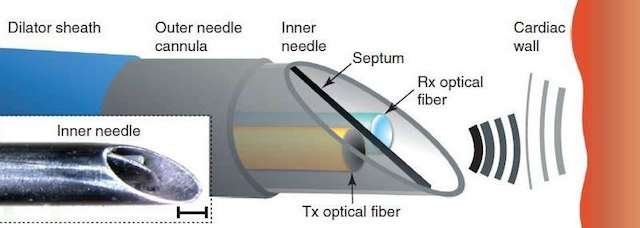Researchers Made Ultrasound Needle for Internal Surgical Images

The surgeries that involve the minimal invasion of the human body is more attracting than the fully-invasive ones as such minimal invasive surgeries mean little scar tissue, reduced recovery time and least risk of infections. However, they do possess some downsides too. Like having a detailed and careful look closely at the tissue being operated during a minimally invasive surgery could be really difficult and for that reason, many a time surgeons are forced to rely on using external ultrasound probes and scanned images taken before the operation.
A new research has been published in “Light: Science and Applications” today presenting a newer much potential option of imaging for minimally invasive procedures, which is an optical ultrasound needle.
The needle is equipped with two optical fibers. One fiber generates the ultrasonic pulses by providing brief light flashes and the other fiber detects the light reflected in the body by the tissues.
Richard Colchester—an author of the conducted research said that the whole procedure occurs in minimal time, providing an extraordinary real-time view of the soft tissues.
Adrien Desjardins—a co-author mentioned that high-resolution imaging has been attained incorporating cheap optical fibers by using below 1mm needle tips.
By far, the ultrasound needle has been tested by the researchers in pigs while performing heart surgery and they are willing to test the needle for other clinical procedures too that might involve minimal invasion techniques. The researchers are also keen on investigating this technology in humans.
Further information could be acquired through the video posted as follows:
It’s a good, non-expensive and beneficial research. If the testing on humans of this technology goes well then, many hospitals and clinics could use it making the surgeries less tedious for the doctors and less scary for the patients.
More Read: An iOS Bug Might Hit Your iPhone on December 2nd
Research Snipers is currently covering all technology news including Google, Apple, Android, Xiaomi, Huawei, Samsung News, and More. Research Snipers has decade of experience in breaking technology news, covering latest trends in tech news, and recent developments.










